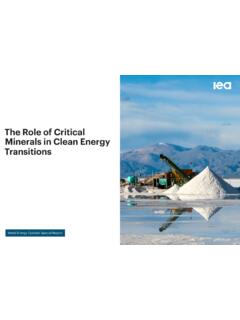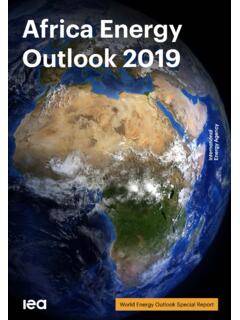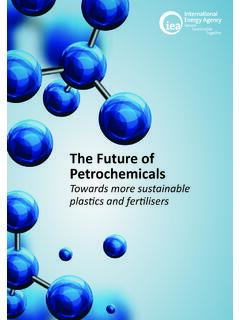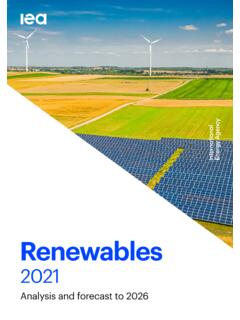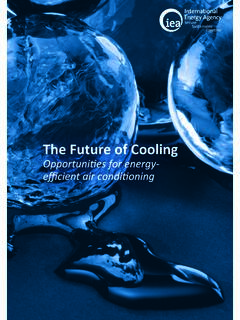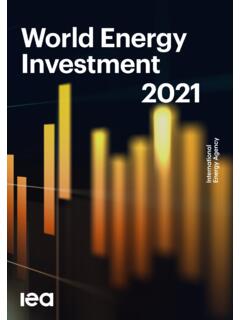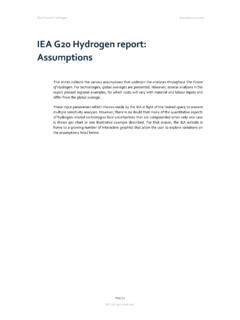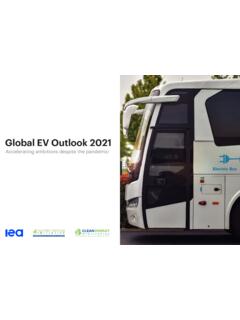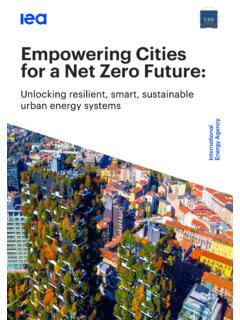Transcription of Global EV Outlook 2020 - .NET Framework
1 Global EV Outlook2020 Entering the decade of electric drive? Global EV Outlook 2020 Abstract PAGE | 2 IEA. All rights reserved. Abstract The Global EV Outlook is an annual publication that identifies and discusses recent developments in electric mobility across the globe. It is developed with the support of the members of the Electric Vehicles Initiative (EVI). Combining historical analysis with projections to 2030, the report examines key areas of interest such as electric vehicle and charging infrastructure deployment, ownership cost, energy use, carbon dioxide emissions and battery material demand. This edition features case studies on transit bus electrification in Kolkata (India), Shenzhen (China), Santiago (Chile) and Helsinki (Finland).
2 The report includes policy recommendations that incorporate learning from frontrunner markets to inform policy makers and stakeholders that consider policy frameworks and market systems for electric vehicle adoption. This edition also features an update on the performance and costs of batteries. It further extends the life cycle analysis conducted in Global EV Outlook 2019, assessing the technologies and policies that will be needed to ensure that EV battery end-of-life treatment contributes to the fullest extent to sustainability and CO2 emissions reductions objectives. Finally, it analyses how off-peak electricity demand charging, dynamic controlled charging (V1G) and vehicle-to-grid (V2G) could mitigate the impact of EVs on peak demand, facilitate the integration of variable renewables and reduce electricity generation capacity needs.
3 Global EV Outlook 2020 Acknowledgements PAGE | 3 IEA. All rights reserved. Acknowledgements The Global EV Outlook 2020 was prepared by the Energy Technology Policy (ETP) Division of the Directorate of Sustainability, Technology and Outlooks (STO) of the International Energy Agency (IEA), under the direction of Timur G l, Head of the ETP Division. Marine Gorner co-ordinated the analysis and production of the report. This report was collectively developed by (in alphabetical order): Thibaut Abergel, Till Bunsen, Marine Gorner, Pierre Leduc, Sarbojit Pal, Leonardo Paoli, Seshadri Raghavan, Jacopo Tattini, Jacob Teter, Sadanand Wachche and Per-Anders widell .
4 Hanjiro Ambrose, Jessica Dunn and Margaret Slattery, from the University of California Davis, supported with primary research, drafting and other contributions to Chapter 4. Shahmeer Mohsin (Institut Polytechnique de Grenoble) also provided valuable contributions. The development of this analysis benefited from support provided by the following IEA colleagues: Nicolas Beltran Achury, Hiroyuki Fukui, Maximilian Jarrett, George Kamiya, Rebecca McKimm, Alison Pridmore, Alan Searl, Siddharth Singh, Lei Xiang, Chengwu Xu and Xiaotong Yang on the national and regional policy sections in Chapter 2; George Kamiya on the micromobility and aviation sections in Chapter 1; Jose Miguel Bermundez Menendez on the fuel cell electric vehicles section in Chapter 1; Zoe Hungerford on Chapter 5.
5 Mechthild W rsd rfer, Director of STO, provided encouragement and support throughout the project. Valuable comments and feedback were also provided by other senior management and colleagues within the IEA, in particular Keisuke Sadamori, Laszlo Varro, Apostolos Petropoulos, Julien Armijo and Zoe Hungerford. The report was edited by Debra Justus. Sebasti n Galarza Su rez (Centro Mario Molina Chile); Alekhya Datta, Ram Krishnan and Shashank Vyas (TERI); Preet Gill, Scott Moura, Lin Osseiran and Raja Sengupta (University of California Berkeley); Xiuli Zhang (University of California Davis); Reijo M kinen, Tommi Muona, Marko Paakkinen and Mikko Pihlatie (VTT Finland); Rakhi Basu, Annika Berlin and Chen Yang (World Bank) and Ivan Jaques (World Bank/ESMAP) provided essential inputs and review for the development of the electric bus section in Chapter 2.
6 The members of Project ReCell (EIT InnoEnergy): Attabik Awan, Anqi Shi, Robin Barkhausen, Gustavo Gomes Pereira, Piotr Grudzie , Thomas K rstgens, Sameer Chourasia, Iryna Samarukha, and Jane Christina Irawan, Global EV Outlook 2020 Acknowledgements PAGE | 4 IEA. All rights reserved. provided inputs, review, and support for the development of Chapter 4. Matteo Muratori (United States National Renewable Energy Laboratory) provided support for the development of Chapter 5. The following individuals have contributed to developing the activities of the Electric Vehicles Initiative (EVI) on behalf of their governments by providing data and assistance, and reviewing this report: Ekta Meena Bibra, Carol Burelle, Aaron Hoskin, Thierry Speiss, Sylvain Roussel and Paula Vieira (Canada); Gabriel Prudencio and Daniela Soler (Chile); Jiayu You (China), Zheng Yali, Hui Lai Zhang, and Jian Liu (China); Pentti Puhakka, Mikko Pihlatie and Marko Paakkinen (Finland); C dric Bozonnat, Clarisse Durand and Syl ne Lasfargues (France); Gereon Meyer and Birgit Hofmann (Germany); Abhay Bakre (India); Tatsuya Nagai and Yoshinobu Sato (Japan).
7 Sonja Munnix, Gerben Passier (Netherlands) and Sacha Scheffer (Netherlands); Mitchel Trezona-lecomte and Nesta Jones (New Zealand); Marianne Dalgard, Ingeborg Kj rnli, Daniel Thorsell (Norway); Mia Abramsson, Lina Kinning, Martina Wikstr m (Sweden); Rob Gould, Bob Moran and Tim Ward (United Kingdom). Other contributors to data collection include Miranda Lello (Australia); Ricardo Zomer (Brazil) with the help of Bruno Carvalho Doberstein de Magalh es (GIZ); Baldur Petursson, Sigurdur Ingi Fridleifsson, J n sgeir H. Porvaldsson and Anna Lilja Oddsd ttir (Iceland); Alok Ray (Society of manufacturers of electric vehicles, India); Andi Novianto (Indonesia); Francesco Vellucci (Italy); Hwanjung Jung (Korea); Huzaimi Omar (Malaysia); Luis Filipe and Olinda Pereira (Portugal); Hiten Parmar (South Africa); Stephan Walter (Switzerland); Yossapong Lao (Thailand) and Michael Berube, Steven Boyd and James Miller (United States).
8 Dan Dorner, Sarbojit Pal, Rui Luo, Ellina Levina and Christian Zinglersen from the Clean Energy Ministerial secretariat were also instrumental to facilitate the development of EVI activities and providing relevant inputs to the publication. Peer reviewers provided essential feedback to improve the quality of the report. They include: Xavier Moreau (Altergrids); Ryan Melsert (American Battery Metals); Qiang Dai, Jarod C. Kelly and Michael Wang (Argonne National Laboratory); Sohail Hasnie (Asian Development Bank); Robert Spicer (BP plc); C cile Goubet (AVERE France); Cristiano Fa anha (CALSTART); Mridula D. Bharadwaj (Center for Study of Science, Technology and Policy); Makoto Dave Yoshida, Tomoya Imazu, Utaka Kamishima, Yasuo Matsunaaga and Tomoko Blech (CHAdeMO Association); Patrick Jochem (DLR); Daniel Noll (Edison Electric Institute); Ana Quelhas (Energias de Portugal SA); Huiming Gong (Energy Foundation China); C line Cluzel (Element Energy); Chiara dalla Chiesa (Enel X); James Copping, Panagiota Dilara, Filip Francois, Maurizio Maggiore, Julija Sakovica and Cesar Santos (European Commission); Viktor Irle and Roland Irle (EV- Global EV Outlook 2020 Acknowledgements PAGE | 5 IEA.)
9 All rights reserved. Volumes); Renske Schuitmaker (Fastned); Patrick Ploetz (Fraunhofer Institute); Ram n Morales Balc zar (Fundacion Tant Observatorio Plurinacional de Salares Andinos); Charlotte Argue (Geotab); Dennis Knese (GIZ); Mathy Stanislaus and Jonathan Eckart ( Global Battery Alliance); Filippo Berardi and Ming Yang ( Global Environment Facility); Kaoru Horie and Yuichiro Tanabe (Honda); Francisco Laver n Simavilla (Iberdrola); Nicholas Lutsey and Dale Hall (International Council on Clean Transportation); J r me Sabathier (IFPEN); Cristina Corchero Garc a (IREC); Nicholas Wagner and Yong Chen (IRENA); Pierpaolo Cazzola (International Transport Forum).
10 Gen Saito, Hiroyuki Kaneko and Yutaka Fukunaga (Nissan); Kevin Johnsen and Svend Soyland (Nordic Energy Research); Emma Wiesner (Northvolt); Luca Maiotti and Benjamin Katz (OECD); Marcello Contestabile (Qatar Environment & Energy Research Institute); Hannah E. Murdock, Rana Adib and Duncan Gibb (REN21); Christell Galbrun-Noel (Schneider Electric); Martin Haigh (Shell); Nikola Medimorec (SLOCAT Partnership on Sustainable, Low Carbon Transport); Thalis P. V. Zis (Technical University of Denmark); Naotaka Shibata (TEPCO); Amy Davidsen, Sandra Roling and James Beard (The Climate Group); Hiroyuki Fukui, Max Parness and Risa Oya (Toyota); Samuel Karslake (UK BEIS); Fabrice Stassin, Jan Tytgat and St phane Levasseur (Umicore); Rob de Jong and Alexander Koerner (UNEP); James Turnure, John Maples and Mark Schipper (United States Energy Information Administration); Cabell Hodge, Jeffrey Logan and Matteo Muratori (United States National Renewable Energy Laboratory); Sebasti n Castellanos, Vishant Kothari, Ryan Sclar and Lulu Xue (World Resources Institute).
